Arrive in Baltra Island. After clearing immigration and customs. Our Monserrat Yacht naturalist guide will welcome you to the Archipelago and escort you to the vessel.
We will sail to Dragon Hill where our first exploration of the Galapagos begins. Dragon Hill is a great introduction to the Galapagos Islands. Here you can relax, swim and snorkel on its crystalline waters.
Dragon Hill Excursion
Cerro Dragón (Dragon Hill) is consider as a prime birdwatching site. You will take a short walk from the beach to a hypersaline (saltier than the ocean) lagoon frequented by pink flamingos, common stilts, pintail ducks, and other species of birds.
We will pass through a Scalesia tree forest; which is one of the most endemic trees of the Archipelago, a quick fact about this iconic specie there are only 400 specimens of Scalesia trees left in the world.
Dragon Hill Snorkeling
After an exciting land excursion, you snorkel off the beach along the rocky shoreline. This is a great snorkeling site where you can swim with green turtles, sharks and rays.



Santiago Island has seen its share of human activity from whalers and pirates over the years, and despite the introduction of goats to the island many years ago; the wildlife of Santiago has otherwise flourished and provides outstanding viewing opportunities. The island boasts marine iguanas, sea lions, fur seals, land and sea turtles, among others. Enjoy great wildlife viewing both on land and in the water.
We will head to Buccaneer Cove to witness the towering cliff wall rock formations.
Buccaneer Cove Panga Ride
We will join into a panga or zodiac and cruise alongside high cliffs and rock formations on this visit, which was a favorite hideout for pirates looking to stock up their boats with food and water. Spot sea lions relaxing on the beach and sea birds nesting in the cove.
Buccaneer Cove Snorkeling
After the panga or zodiac ride, we can jump in the water and snorkel along playful sea lions and fur seals.
In the afternoon the excursion will be to Egas Port to see the salt crater as well as a dark sand beach and tidal pools.
Puerto Egas Excursion
The spectacular shoreline of Puerto Egas, also known as James Bay spots a great number of shore birds and reptiles – the beach area is home to a plethora of wildlife.
Puerto Egas Snorkeling
We will do another snorkel activity and jump into the water right off the beach to explore Puerto Egas' interesting underwater world.
Keep your eyes peeled for rays, turtles, and reef sharks while snorkeling. After this activity, you will visit the large tidal pool area – marine iguanas and Sally Lightfoot crabs are everywhere.



Today we will visit the most western site of the Galapagos Islands, Espinoza Point in Fernandina Island. This island is also one the most pristine on the archipelago as no foreign species have been introduced. We will visit Vicente Roca Point, on Isabela Island, famous for its rich underwater sea life thanks to its location on the Bolivar Channel.
Vicente Roca Point Snorkeling and Panga/Zodiac Ride
Vicente Roca Point has great deep-water snorkeling at one of the richest marine havens on Earth (Bolivar Channel). Vicente Roca Point is renowned for its Galapagos green turtles, which are very numerous on the bay. Although the spot is known for its high concentration of green turtles, sharks and rays can also be observed when underwater visibility is good.
We will take a panga / zodiac ride along the coast to observe a great diversity of sea and coastal birds; including Nazca and blue-footed boobies, noddies, brown pelicans, penguins, flightless cormorants.
Espinoza Point Excursion
Espinosa Point on Fernandina Island is one of the most pristine islands in the world, with none of man’s introduced species. From here we can see the island of Isabela across the Bolívar Channel, an area that boasts some of the highest diversity of endemic sea fauna in the Galapagos.
Fernandina is the youngest of the Galapagos Islands.
When landing, check out the tidal pools where there is abundance of sea life, including small fish and mollusks. If we are lucky, a sea turtle or ray may be trapped in the pools. A little further ahead we will pass through some marine iguana burrows and sea lion colonies. The trail continues to where several flightless cormorants have their nests. This remarkable bird is only found in western Galapagos, and experts estimate that they may only be a few hundred individuals in total.
Espinoza Point Snorkeling
After the exciting hike, you experience one of the best snorkeling sites on the archipelago. Marine iguanas, Galapagos penguins, and sea turtles are some of the species inhabiting this site.



We will continue exploring to the pristine and remote West of the Archipelago. Our visits today are Urbina Bay and Tagus Cove on the west of Isabela Island, where we will have our first encounters with flightless cormorants, penguins, giant tortoises and beautiful landscapes and amazing snorkeling opportunities.
Urbina Bay Excursion
Urbina Bay is a fascinating visitor site that came to be as the shallow sea bottom uplifted in 1954 showing a large coral reef sticking up above sea level. Because of this, Urbina Bay is one of the newest features in the Galapagos. This visitor site is located at west of Isabela and provides spectacular views of the Alcedo volcano. The long trail starts on the beach where a wet landing is made. In this location, you will likely see wild Galapagos Giant Tortoises and Galapagos Land Iguanas.
As the trail circles back towards the shore line you'll come across colonies of the unique Galapagos Flightless Cormorant which lost its ability to fly.
Urbina Bay Snorkeling
This is also a great spot for snorkeling, as you can come close (6ft away) to a Galapagos Penguin Colony and see Galapagos Marine Iguanas feeding underwater.
Tagus Cove Excursion
Tagus Cove is located on the Northwestern coast of Isabela. It is a historical site visited by Charles Darwin in 1835, where graffiti has been carved into the rock walls by visitors over the past centuries. This spot has been frequented by whalers and pirates since the 1800s that used the area as anchorage. The name of the site dates back to 1814 when it was visited by a British ship, The Tagus, which had anchored there in search of giant tortoises to be used as food supply on the boat.
Here, we will admire a variety of seabirds, such as blue-footed booby, brown noddy, terns, flightless cormorant and Galapagos penguins depending on the season. Occasionally you might see woodpecker finches, the Galapagos hawk, the yellow warbler or a large-billed flycatcher. After a dry landing one, we can climb up the trail to visit Darwin 's Lake. The lake is located on the slopes of Darwin Volcano and is, surprisingly, a salt water lake above sea level.
Tagus Cove Snorkeling Meanwhile, in our snorkeling session there are chances to see sharks, turtles and sea stars. You may also see various different types of colorful fish.



Breakfast
Lunch
Dinner
Black Turtle Cove Excursion
Black Turtle Cove
We will explore the mangroves by panga/zodiac to find rich marine wildlife between the fresh and salt waters. Keep any eye out for manta rays and sea turtles in this tranquil ecosystem. Whitetip reef sharks can also be seen gliding by.
Santa Cruz Highlands Excursion
We will visit the highlands of Santa Cruz and see the Galápagos giant tortoise in its natural surroundings. We will explore the area and its incredible underground lava tunnels – some are more than 1km (.6 mi) long! As we walk along the volcanic tubes and keep an eye out for the (mainly) nocturnal barn owls that sometimes roost here.
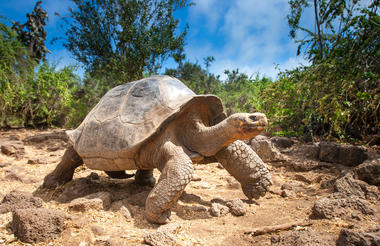

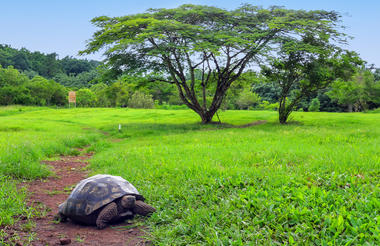
Chinese Hat Excursion
Explore Chinese Hat’s beautiful landscape and spectacular white-coral sand beach. It's easy to see why the name, Santiago islet is shaped like an old-fashioned Chinaman's hat, a gently sloping cone rising out of the clear Galapagos water. Because of its distinctive shape, Sombrero Chino has fascinated visitors.
Chinese Hat Snorkeling
Snorkel right from the white-coral sand beach and come face to face with playful sea lions and large schools of tropical fish. Keep an eye out for marine iguanas and penguins too!
Sullivan Bay Excursion
Walking through Sullivan Bay offers an extraordinary journey into the volcanic origins of the Archipelago. The hike will take you across a perfectly preserved Pahoehoe lava flow, providing the opportunity to observe the delicate textures of this rare type of lava.
While may appear barren and lifeless landscapes, a closer look reveals resilient pioneer plants, scurrying lava lizards, and small birds. Along the shore, penguins, pelicans, and oystercatchers add a touch of life to the stark environment.
Sullivan Bay Excursion
After the excursion, we will have snorkeling time from the beach with sea turtles’ lions, sea lions, reef sharks, and Galapagos rays.

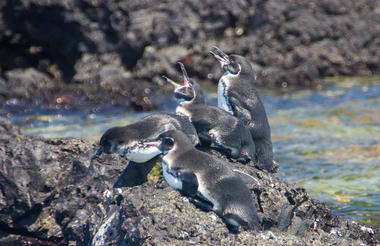

North Seymour Island Excursion
The morning starts with a visit to North Seymour Island, a spectacular showcase of the Galapagos Islands' diverse wildlife. This fairly flat island is home to a thriving population of blue-footed boobies and frigate birds.
The trail will walk you through a forest of low, bushy vegetation, where you'll have the opportunity to witness the fascinating courtship dance of the blue-footed boobies. The island's coastline also let you observe sea lions and marine iguanas basking in the sun. The large frigate bird colonies are a sight, especially when the males expand their bright red throat pouches to attract mates.
This is an ideal spot for birdwatching and photography sessions.
North Seymour Snorkeling
This small island is one of the most important fishing sites for Marine Birds. This is a very popular place for many travelers and ornithologists to observe the spectacular and diverse number of birds of the Galapagos Islands.
Also, we will have the opportunity to observe whitetip reef sharks, colorful fish, rays, sea lions, and sea turtles inhabit the waters of North Seymour, making it one of the best snorkeling sites in Galapagos.
Santa Fe Island Excursion
This Island is known for its picturesque bay and turquoise waters, perfect for swimming and snorkeling. The island hosts a large amount of land iguanas unique to Santa Fe. Watching for these magnificent creatures as we walk through the giant prickly pear cactus forest will make a unique experience. The island's calm and clear waters are ideal for spotting the marine life, including sea turtles, rays, and colorful schools of fish. Santa Fe also offers a chance to see the Galapagos hawk and various endemic finches.
This day offers a combination of terrestrial and marine activities as you will also do kayaking and panga rides, showcasing the diverse landscapes and wildlife the Galapagos Islands are famous for.



Punta Pitt Excursion
We will have the chance to enjoy amazing wildlife watching and interesting geological formations on this fascinating expedition. Arrive at a quiet cove on the eastern tip of San Cristóbal to explore Punta Pitt. Made up of volcanic tuff substrate, it's the only site in the Galápagos where it's possible to see three species of boobies and two species of frigatebirds.
Punta Pitt Snorkeling
We will do snorkel around Punta Pitt Island and spot schools of fish swimming below. On the shore we can admire the nesting birds and sun-bathing sea lions.
Witch Hill Excursion
Cerro Brujo (Witch Hill) is a breathtaking white sand beach on San Cristobal Island's northern coast.
This beach was one of the first sites visited by Charles Darwin. It's an attractive spot for walking and enjoying the landscape, with its powdery white sand and turquoise waters. The area is home to a large sea lion colony, and the nearby lagoon often hosts several bird species, including pelicans and blue-footed boobies.
Witch Hill Snorkeling
The clear waters of this place make an ideal spot for snorkeling, where you can encounter rich marine life.
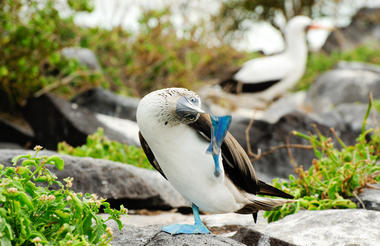

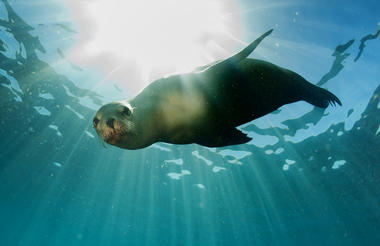
Tijeretas Hill Excursion
Tijeretas Hill is a tourist attraction on the San Cristobal Island, offering visitors a spectacular panoramic view and the opportunity to enjoy the rich marine life that surrounds the area.
The name “Tijeretas” refers to the frigate birds that inhabit the region, also known as earwigs.
It is one of the only places where you can watch the two species of frigate birds nesting in the same colony.
Lobos Island Excursion
We will explore this tiny island by foot and boat for some great wildlife encounters. Taking a panga/zodiac ride to view the sea and shore birds nesting and feeding. We will be able to spot a small colony of blue-footed boobies as well as two species of sea lions.
Lobos Island Snorkeling
After the excursion, we will have time to discover the marvelous marine wildlife inhabiting this site, including sea turtles and playful sea lions.
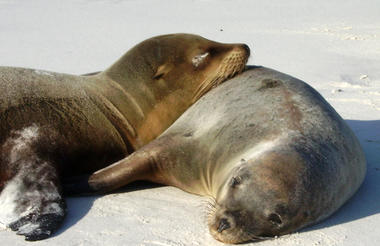


Española Island is one of the oldest in the Archipelago. We will visit the white sandy beach of Gardner Bay's and the bird colonies of Punta Suárez.
Arriving in the morning, we will spend the day exploring on shore and snorkeling at Gardner Bay. After lunch, we will sail to the western side of the islands to Punta Suárez, known for its amazing bird colonies and home to the waved albatross (April and December).
Gardner Bay Excursion
The morning starts with a visit to Gardner Bay's magnificent white sandy beach, home to sea lions and sea birds. Be sure to explore the beautiful turquoise water and its incredible sea life. Spot young sea lions and large schools of surprisingly big tropical fish, including yellow-tailed surgeonfish, king angelfish, and bump-head parrot fish.
Gardner Bay Snorkeling
Also, we will visit Tortuga Rock for a spectacular snorkeling experience. Spot playful young sea lions and large schools of tropical fish, including yellow-tailed surgeonfish, king angelfish, and bump-head parrot fish. Look for white-tipped reef sharks napping on the bottom.
Punta Suárez Excursion
Punta Suárez is one of most rich wildlife landing sites in the Galapagos Islands. Be greeted by surfing young sea lions on arrival. Head to the trail to find many species of nesting sea birds, and, if lucky, see the waved albatross. Follow the path up to a cliff for great views over the ocean, and watch sea birds gliding in the wind.
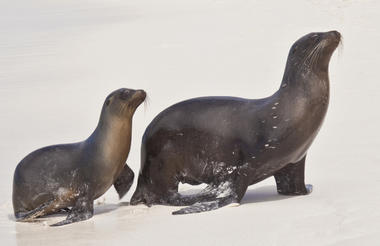
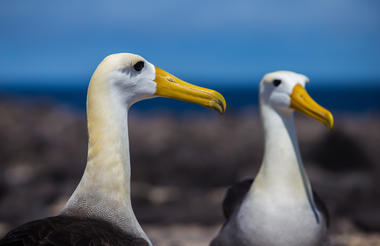
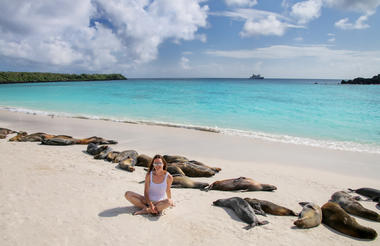
We will arrive at Punta Cormorant on Floreana Island, where we will enjoy guided walks to observe the abundant birdlife and wildlife while learning about the island's fascinating natural history. We will explore the vibrant underwater world with a snorkeling excursion at Champion Islet, then visit the historic Post Office Bay to discover its unique maritime tradition.
Punta Cormorant Excursion
Floreana Island Visit Punta Cormorant, are the only landing site on Floreana Island. Here we will discover two amazingly different beaches: one with green sand, colored by olivine crystals, and another with white sand particles known as 'Flour Beach'.
We will spend the afternoon observing flamingos and other shore birds feeding in the lagoon. Spot penguins and marine iguanas at the water’s edge.
Champion Islet Snorkeling
We will have a personal encounter with the playful sea lion colony that reside in the waters off this tiny island. Keep an eye out for sea turtles, rays and colorful fish swimming by. There can be currents in this area, this activity should be done by strong swimmers only.
Post Office Bay Excursion
During the visit to Post Office Bay, we will learn about its unique historical place. In the late 18th century, English whaling vessels placed a barrel here to be used as a post office.
Today, the box is used mainly by tourists, who may drop off and pick up unstamped letters to be carried to far destinations. We suggest to continue the tradition – leave a letter and take one to deliver (be sure it makes it to the correct location).



Cormorant Point
Breakfast
Lunch
Dinner
Charles Darwin Research Station Visit
On the last day of cruise, we will visit Fausto Llerena Breeding Center a great place to observe many species of tortoises and land iguanas in captivity. We will witness the famous Galápagos tortoise up close – a corral houses adult tortoises, and a nursery care for the young until around age three when their shells have hardened.
This area also houses the Charles Darwin Research Station, a scientific organization initiated in 1964, which works to preserve the Galapagos' ecosystem through the conservation efforts of scientists, researchers, and volunteers.
While the offices themselves are not open to visitors, the research station provides a study location for international scientists and environmental education for the local community.
Santa Cruz Highlands Excursion
In the afternoon you will visit the highlands of Santa Cruz and have the chance to observe the Galápagos giant tortoise in its natural surroundings.
Explore the area and its incredible underground lava tunnels – some are more than 1km long!
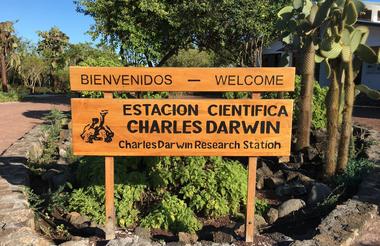
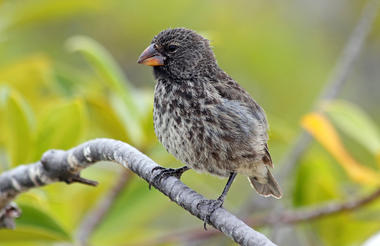
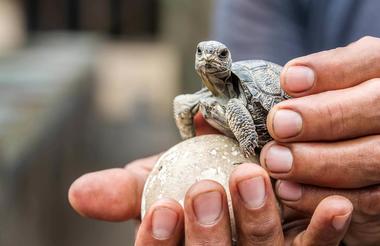
Today you will be visiting the beautiful and remote Genovesa Island. This northern island, famous for its red-footed colony, is a paradise for bird lovers. It is estimated that about 200,00 Red-footed boobies live on this island.
Darwin Bay Excursion
Darwin bay was formed by the collapse of the flooded caldera of Tower Island, another name used for Genovesa. After landing at a small sand and coral beach, it easy to realize why this island is a bird lover paradise. Among the bird species found here, the most common are swallow-tailed and lava gulls, mockingbirds, yellow-crowned night herons, lava herons, Galapagos doves and yellow warblers.
You will continue on a short and flat trail to encounter red- footed booby and great frigatebird nests.
Prince Phillips’s Steps Excursion
El Barranco or Prince Phillips’s Steps as otherwise known, was named after a visit by the British Monarch in 1964. El Barranco's steep 81-foot stairway leads up to a high cliff-face that opens out onto the plateau surrounding Darwin Bay.
Here an amazing view can be appreciated. Once at the top of the stairway you will meet Nazca boobies, red-footed boobies, mockingbirds, and finches along the way of a palo santo trail.
It will also be possible to see wedge-rumped storm petrels swarm and short-eared owls



Bartolomé Island Excursion
During this excursion you will hike to Bartolomé's summit to have a perspective of the islands' not-too-distant volcanic origins, and enjoy a panoramic view,
You will be able to see other Galapagos Islands in the distance as well as Pinnacle Rock, the island’s famous towering landmark.
Take the opportunity to swim and snorkel around Pinnacle Rock, one of the most iconic volcanic rock formations on the islands. Home to Galapagos penguins, friendly sea lions, sea turtles, and a huge variety of fish, Bartolomé and its surrounding waters are a fantastic place to explore the natural wonders of the Galapagos.
Bowditch Point Excursion
This is a unique place where almost nobody visits, on this amazing spot you can relax on a powdery beach, snorkel around turquoise water islets and hike beside salt pools and dried white corals.
In the afternoon, you will visit one of the last off-the-beaten-path sites in the Galapagos Islands. This pristine site offers you a great snorkeling session with giant schools of black-striped salema, parrotfish, and Mexican hogfish, or you can enjoy kayaking or SUP if you prefer. Afterwards, you spend time on the beach relaxing or walking around it.



Breakfast
Lunch
Dinner
Bachas Beach Excursion
Bachas Beach´s sand is made of decomposed coral, making it soft and white, and a favorite site for nesting sea turtles.
Here, you can spot abundant Sally Lightfoot crabs on the lava rocks along the water's edge, these crabs will eat anything they can get their claws on! Also, you will be able to see a wide range of wildlife, including flamingos, hermit crabs, black necked stilts, and sea lions.
Baltra Airport
You will be transfer to the Baltra airport in order to take your fight back to Ecuador mainland.


Breakfast





